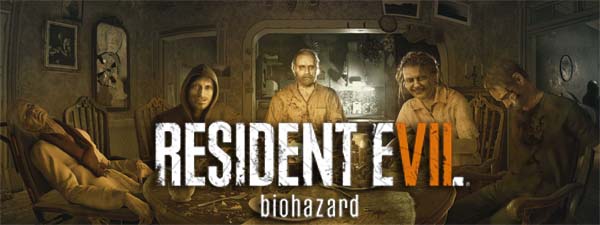
It's been a long time since I've given a crap about Resident Evil. I loved the classic Resident Evil games. The Play Station original is a foundational game for me, and jump-started my interest in horror and the macabre. I felt like the series jumped the shark with Resident Evil 4, however, and my interest in the series tanked with its abandonment of horror in favor of schlockey action-shooter gameplay. I played through Resident Evil 5's co-op with a friend, but didn't really enjoy myself, and after playing the abysmal demo for RE6, I skipped that one entirely.
So I was genuinely excited by Resident Evil VII: Biohazard. The popularity of first-person horror games, and the phenomenon that was P.T. / Silent Hills (not to mention the success of Resident Evil REmastered on Steam) obviously seems to have kicked Capcom in the butt and reminded them that there is still an audience for genuine horror games - an audience that mainstream gaming has neglected for most of the last decade. I'm not sure if development of REVII started as a response to P.T., or if it was already in the works following the success of games like Amnesia, Outlast, and Alien: Isolation. Either way, it's good to see major publishers embracing the genre again.
The family's new - but familiar - mansion
This new Resident Evil really does go back to the franchise's roots. The early hours of the game actually feel a lot like a combination of the original Resident Evil and Resident Evil 3: Nemesis, but updated with a first-person camera and a lot of modern horror contrivances. Long-time fans of the series will recognize the safe rooms and item-boxes. The classic health status indicator is now part of a watch on the character's wrist that you can see whenever you pull up your inventory. There's a foyer with a balcony. Doors are locked by silly, esoteric puzzle mechanisms that require themed keys, crests or various other stand-ins for keys. There's even a booby-trapped shotgun to tease you at the start of the game. Some of these elements of design feel appropriate, while other ham-fisted call-backs admittedly feel like the developers were trying too hard.
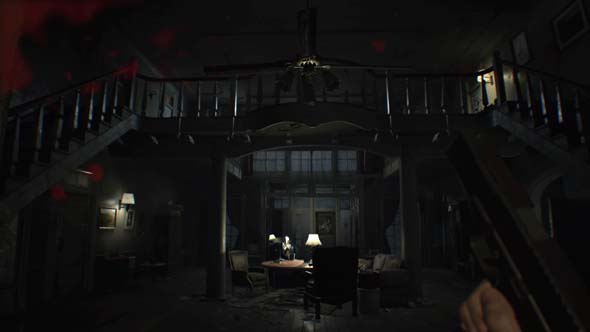
The mansion is new, but has many call-backs to the first game.
The map is well-designed, with its claustrophobic hallways, shortcuts, and lots of visual detail. Lighting is excellent, though the game is a bit too dark at the recommended brightness level (at least without a flashlight), and it becomes washed-out at higher brightness settings. Sound design is also quite exceptional, with the game giving great audio feedback (especially for the pursing stalkers). I also like a lot of the little details, particularly how using a key to unlock a door takes a small amount of time, during which you are vulnerable.
The family also makes for some excellent antagonists, especially compared to the likes of stupid, campy villains like Albert Wesker and Salazar. These villains have a lot of character, and there's enough detail in the mansion to give a sense of who these people might have been before they went off the deep end: the collectible football bobbleheads, for example. And on top of that, they are genuinely disturbing and threatening, and the whole game would probably be scary enough if you just spent the whole time avoiding them and trying to escape their murder house.
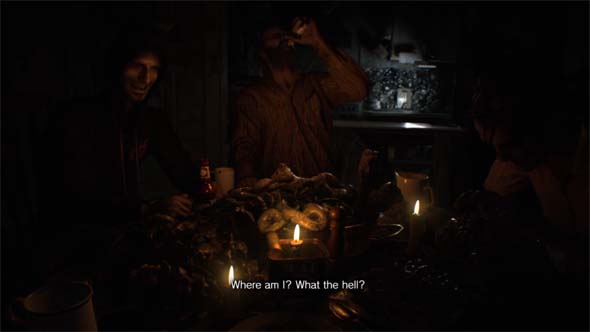
The family makes for genuinely disturbing villains that put RE's earlier villains to shame.
The save system is kind of an odd hybrid of the classic save system and more modern checkpoint systems. The logistics of the classic system have been scaled back, as you no longer require a consumable item (ink ribbon) to manually save (at least not on the default difficulty). But the game will also checkpoint you at certain points, and it maintains a single autosave slot with your checkpointed progress. So if you die to one of the obnoxiously-hard bosses, you don't have to go back a whole hour to your last manual save; instead, you get to restart at the most recent checkpoint.
However, the manual saves still have value, because Biohazard is structurally very similar to the original Resident Evil - both superficially and in terms of gameplay... [More]
a4e07563-fcc1-4e63-88fa-f5d8f517792b|1|5.0
Tags:Resident Evil, Biohazard, Resident Evil 7: Biohazard, Capcom, horror, survival horror, shooter, first person, inventory, resource management, mansion, autosave, save system, puzzle, logistics
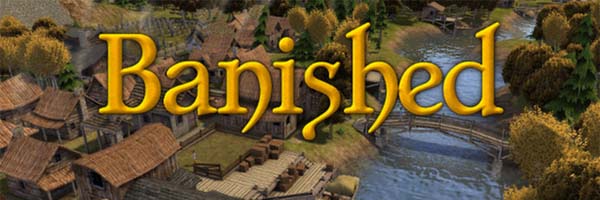
In between games of Madden 17, I need something to tide me over until the release of Civilization VI consumes my life at the end of October. As such, I did what I usually do in these situations, and I dove into my Steam backlog to look for something that's been sitting around, unplayed, for a couple years. Usually, I try to find some short games like This War of Mine or Papers, Please. I try to avoid the bigger games because they can end up consuming more of my time than I want them to, and if I jump to something else, then I may not go back to such a game to give it a fair chance. Sorry, Master of Orion, Endless Legend, and Endless Space 2, you'll all have to wait until after my upcoming Civ VI bender before I can give any of you a fair chance. That being said, I decided to take a risk and try out a city-builder that I've had sitting around for awhile. I love city-builders, and so this could easily have dragged on for weeks or months, but I hoped that the narrow scope of this game would mean that it wouldn't take as long to get my fill of it.
Banished is a game that offers unforgiving tough love. I feel like this game is the "Oregon Trail" of city-builders, and it's enjoyable as a challenging game of resource management. Unfortunately, it isn't exactly the best at explaining itself, and so it requires a lot of trial and error in order to get going. There's a lot of cycles of cascading success or failure, so you'll likely be restarting your games multiple times before you get anything remotely close to a sizable village. I would also advise that you try to keep multiple save states for your early cities so that if you make a small mistake that starts to spiral into catastrophe, you can reload and fix it without having to restart the entire game.
The tutorial explains a lot of the basic functionality of the buildings, but it never really addresses how to get the most out of these buildings. This results in an unnecessarily high learning curve and bar of entry as you try to stumble upon the optimal placements and uses of buildings. I kept making little mistakes that had big repercussions that forced me into restarting my very first game multiple times - even going so far as to save the random map seed so that I could restart in the same map and try different approaches to some things.
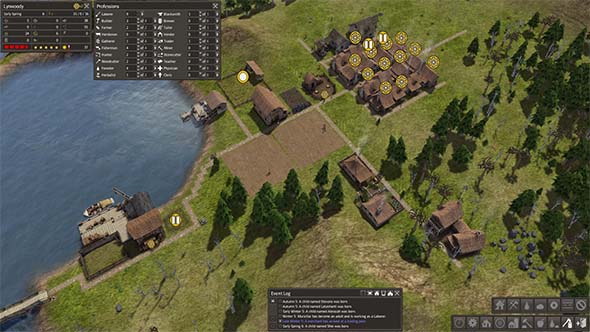
I had to iterate through some sub-optimal building placements before stumbling upon a viable city.
An example of a small misstep that crippled a game was that I built a farm that overlapped slightly with a single tree in one corner. Normally, farms are created as soon as you finish zoning them, and you simply have to select which crop to plant and assign workers to work it. But if there are any rocks or trees, then you must first remove them in order for the farm field to be built (like with any other building). So while I waited for some laborers to come chop down the trees (uncertain why nobody was bothering to cut down that one fracking tree!) spring passed and the window for planting closed. So the farm went un-used for the rest of the year, I had no crops saved up, and several adults and children died, leaving my village under-staffed for the following year. So I restarted and placed my farm entirely in an open field, planted during the first spring, and collected a healthy reserve of wheat to keep all my villagers fed through the winter... [More]
f4887e6d-007a-43fa-9a02-db5781c5c44b|1|5.0
Tags:Banished, Shining Rock Software, Steam, indie gaming, city simulation, simulation, strategy, survival, medieval, renaissance, agriculture, farming, resource management, food, minerals, roads, seasons, winter, Oregon Trail
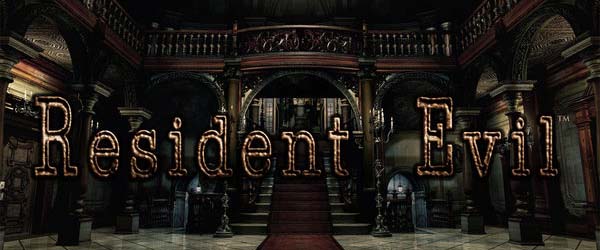
Not having a GameCube meant that I unfortunately missed out on some pretty high-quality games. Probably the most notable ones were Eternal Darkness and the remake of Resident Evil, neither of which, by itself, was enough to sell me on a console. I've since been able to play through a friend's copy of Eternal Darkness, and I had started on Resident Evil, but never got around to finishing it. When the HD remaster showed up on PSN, I was hesitant to buy it, since I knew that I could just play it on my friend's GameCube eventually.
Best of both worlds at the tip of your thumb
However, something in the previews really intrigued me. And that was the compromise that Capcom found for the never-ending conflict between the tank-style controls of the original PSX game and the analog control of newer games. Since I grew up with Resident Evil, Silent Hill, and other survival horror and similar adventure games, I've never had a problem with tank controls. They tend to be the lesser evil when dealing with static camera angles that change unpredictably (as in Resident Evil), and they are perfectly serviceable for behind-the-back or overhead cameras (as in the outdoor areas of Silent Hill). This ensures that the controls remain consistent during camera angle changes, since they are always relevant to the character rather than the camera.
But apparently, some people hate that control paradigm. They criticize it for making the characters feel too slow and lumbering, and that it lacks precision. The controls have oft been cited as one of the reasons for Resident Evil's declining popularity after Resident Evil 2, and supposedly ditching them was a major factor in the "renaissance" that was [supposedly] Resident Evil 4. But let me remind you that Resident Evil 4 had the exact same controls, and the character was just as slow and lumbering (if not moreso). The only difference was that the camera was moved to behind-the-back, and the gameplay switched to an action shooter rather than a more adventure-puzzle kind of game. So really, your problem was never with the controls...
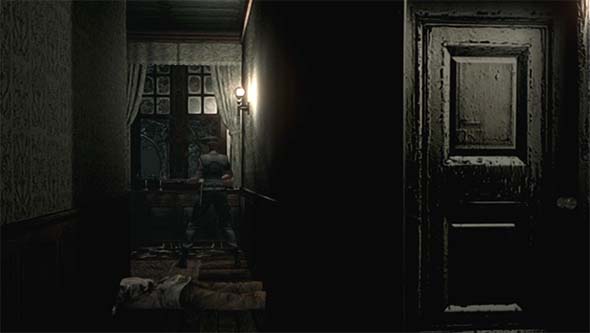
The original Resident Evil was criticized for how its controls and camera lead to frequent blind corners,
wasted ammunition, and cheap kills. The critics were right, but it wasn't game-breaking...
Regardless, analog control has its own baggage train of problems. Pressing the stick in one direction can cause the character to make sudden changes of direction if the camera suddenly changes. This can be mostly avoided by locking the character's movement as long as the player doesn't release or rotate the stick - and the HD Remaster does implement this. But this still leads to sudden turn-arounds when the player needs to move the character around a corner, since you sometimes have to move the stick to the exact opposite direction that you were pressing. And in cases in which the camera angle changes at the point where a change of direction is required to go around a corner or navigate an obstacle (which happens often), then the character can easily get lost in a cycle of spinning around between the two camera zones.
So there is no perfect solution to the problem of static cameras, but I tend to prefer the tank method due to its guarantee of consistency - even at the cost of some slow turning speeds. In any case, advocates of either paradigm should find exactly what they want in this remaster, since both configurations are implemented in the remastered game's default control scheme! Capcom's clever (and elegant) solution was to simply map the tank controls to the directional pad, while leaving the free analog movement on the analog stick. Players are, thus, free to alternate between whichever control they prefer without even having to go into a menu to change it. You can even alternate between them, on the fly, in the heat of the action if the situation warrants it, because I can definitely see how the analog movement could work well in some of the [rare] larger, open areas of the map (particularly for boss fights).
It's OK to hate these red-headed step-zombies
Most of the changes introduced in the GameCube remake serve to add further challenge. The most prominent display of this is the new "Crimson Head" zombie mechanic. If you kill a zombie and didn't manage to get lucky enough to blow its head off, you must burn its body in order to prevent it from resurrecting later in the game as a more dangerous "Crimson Head". These red-headed zombies are faster and more damaging than their precursor form. They can rapidly run across a room and grab you before you even realize they are there. They are also very well-tutorialized, since most players will probably encounter their first Crimson Head while attempting to retrieve the Armor Key from the hallway trapped with suits of armor on rails. The previous hallway includes a dead body that (if you didn't go out of your way to burn previously) will resurrect at this time. This hall has a system of mirrors in place that allow a tremendous degree of visibility from virtually every camera angle, meaning that whichever door you enter from, you'll have an opportunity to see the Crimson Head coming after you. It's a frantic and frightening moment!
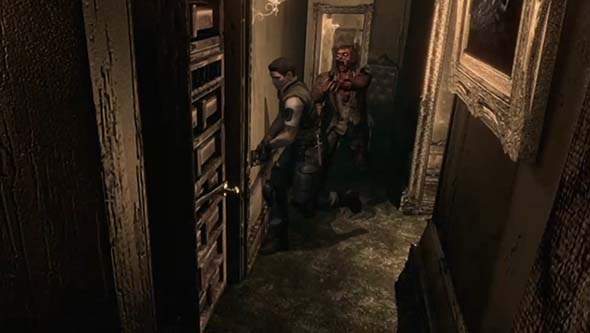
Bodies that you don't burn will resurrect as faster, more deadly "Crimson Heads"
that are difficult to avoid and require a second investment in resources to defeat.
Almost any zombie in the game can potentially turn into this more dangerous form. Destroying their head with a lucky shot or burning their bodies are the only ways to permanently ensure that they can't attack you... [More]
bedbfed9-e92f-45b6-b083-1b57db8977fc|1|5.0
Tags:Resident Evil, HD, remaster, remake, port, Capcom, survival horror, Jill Valentine, Chris Redfield, Albert Wesker, mansion, zombie, save, save system, tank controls, checkpoint, typewriter, ink ribbon, resource management, puzzle, logistics, GameCube, b-movie, Shinji Mikami
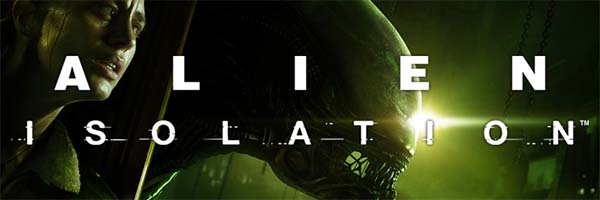
It's been a long time since there's been a mainstream survival horror game. Alien: Isolation may not be the same kind of traditional survival horror as its classic Resident Evil, Silent Hill, or Alone in the Dark predecessors, but many players may not have much familiarity with the stricter resource management that is required in a game like this.
Dead Space and The Last of Us had resource management elements, but since those games were more action-oriented, you weren't under as much pressure to conserve supplies. Alien: Isolation, however, is a bit slower and requires slightly better management, since it isn't quite as generous about providing supplies. As such, I thought I'd offer a few tips for inexperienced survival horror players to help them cope with surviving on Sevastopol.
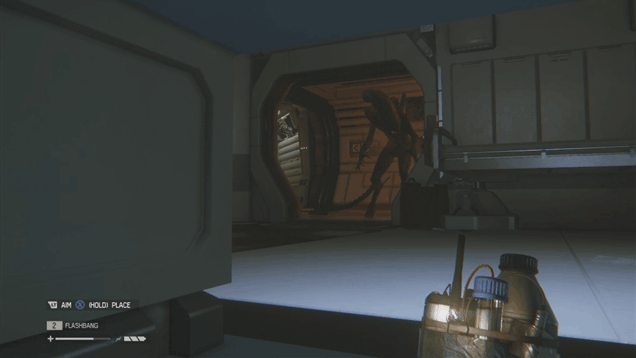
Don't hide in plain view of a doorway or down the hallway, since the alien will be able to see you.
I'm not going to post specific tips for problem areas of the game. For those, you can look for actual walkthroughs provided by other authors. Instead, these will be five general-use tips that will apply to the majority of the game:
[More]
9bb4d77a-97dd-4679-b3b1-cde0ba3cf6cd|1|5.0
Tags:Alien Isolation, Alien, the Creative Assembly, Ripley, science fiction, horror, survival horror, resource management, crafting, memo, flamethrower, med kit, molotov

I've heard that a lot of players are complaining about the save system of Capcom's new Resident Evil 6. I haven't played the game yet because RE5 sucked, and the demo for RE6 sucked, so I can't comment on that game. What I can do, though, is take a moment to reflect on the genius of the classic Resident Evil save system.
Most of my readers know me as a Silent Hill fan [boy], so it's uncommon for me to heap praise upon Resident Evil. But I actually am a big fan of the original game (it was one of my favorite PlayStation games). Maybe some day, I'll get around to writing about how Resident Evil 4 killed my interest in the franchise...
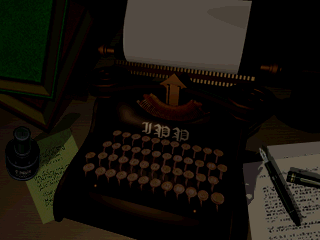
Would you like to save your progress?
[YES] NO
Resident Evil took a unique path in terms of it's save-game system. I'm not sure if it was the first to use this particular style of system, but it was definitely one of the best implementations that I played!
During the PSX era of the late 90's, game saves generally took one of 3 forms:
Resident Evil falls firmly in that last category, but with one significant (and game-changing) caveat: in addition to only being able to save at pre-defined locations, the ability to save was also tied to a consumable inventory item! [More]
11efae01-91a1-4c73-9ff1-8965e9a48534|9|4.2
Tags:Resident Evil, Resident Evil 5, Resident Evil 6, Shinji Mikami, save, save system, autosave, checkpoint, survival horror, resource management, typewriter, ink ribbon, Silent Hill, Amnesia: the Dark Descent
|

| 12 | | | | | | | 60 | | 11 | | | | | | | 55 | | 10 | | | | | | | 50 | | 09 | | | | | | | 45 | | 08 | | | | | | | 40 | | 07 | | | | | | | 35 | | 06 | | | | | | | 30 | | 05 | | | | | | | 25 | | 04 | | | | | | | 20 | | 03 | | | | | | | 15 | | 02 | | | | | | | 10 | | 01 | | | | | | | 05 |
|